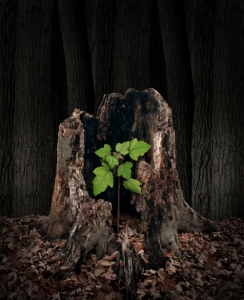When journeying, the most common method for bridging the ordinary and non-ordinary worlds, the practitioner’s soul is freed from physical form and takes flight into the formless realm. S/he becomes an intermediary or facilitator between these worlds for the purposes of gaining knowledge, divination and healing.
A basic understanding of shamanism is that ailments, or dis-eases occur through one of three classic causes: disharmony, fear and/or soul loss. The art of bringing someone out of dis-ease requires “mending the soul.” This is accomplished by discovering the root cause or true source of the illness. The work of the shaman is to journey into the formless realm and petition the spirits on behalf of those they are assisting so that healing occurs. As the practitioner continues to work with the spirits, trust occurs and bonds are formed. It is then that the spirits become allies of the practitioner.
While shamans do create relationships with spirits in the spirit realms, shamanism isn’t considered to be a religion or belief system. At the same time, shamanism does work well with other traditions or religious paths. Generally, the practices are woven into the cultural customs of the area. Rather than having a dogma, shamanism is comprised of experiential knowledge that is received from directly working with the spirits, or spirit allies, through the journeying process.
Shamanism is result oriented. If a method is tried and doesn’t work, it isn’t used. What works for one practitioner may not work for another. Each has her personal medicine bag of tried and true modalities. Therefore, shamanism is an experiential “knowing” rather than a belief system.
 It is through first hand experience and trial and error that the original observers of life discovered the roots of shamanism. Through asking the big questions and closely observing the self, others and exploring both the ordinary and non-ordinary worlds, the first shamanic practitioners uncovered healing methods that worked. Despite periods when shamanism was nearly obliterated by religious influences, these methods have been passed down through the ages, eventually making their way into modern society.
It is through first hand experience and trial and error that the original observers of life discovered the roots of shamanism. Through asking the big questions and closely observing the self, others and exploring both the ordinary and non-ordinary worlds, the first shamanic practitioners uncovered healing methods that worked. Despite periods when shamanism was nearly obliterated by religious influences, these methods have been passed down through the ages, eventually making their way into modern society.
Much of the continuation of contemporary shamanism can be attributed to an American anthropologist named Michael Harner, the creator of The Foundation for Shamanic Studies. In the 1950s, Harner began traveling to indigenous cultures to observe their shamanic practices. After many years of firsthand experiences, he came to recognize that many of the practices among these individual societies had common elements. Harner brought these common or core practices back to the Unites States and, eventually, began to teach them under the name “core shamanism.”
Harner, deemed a shaman by those indigenous shamans from the cultures in which he worked, first began teaching core shamanism in the 1970s. Since that time, tens of thousands of modern day practitioners have been taught the core elements of shamanism including journeywork.
The ancient “magic” of shamanism continues to mend the soul. More and more people are looking for deeper ways of healing and are actively seeking those who work in the shamanic field.
Contemporary shamanic tools include both those of ancient wisdom as well as those that have come on the scene in the modern era. While each shamanic practitioner may incorporate their own flavor of modalities, common tools most likely include journeying, shamanic extractions, soul retrievals, psychopomp (guiding souls into the afterlife), vision quests, sweat lodge, depossession work, weather working, house clearings, divination, shapeshifting and working with power animals, spirit allies, and ancestors. These and many other modalities are being offered by individual shamanic practitioners around the globe.
Throughout the Shamanism: Bridging Worlds section of Soul Bridging, you will learn much more about these practices, tools and rituals involved in this ancient yet modern healing art. I invite you to join me, Regina Rivers, in exploring these magical non-ordinary realms together. Aho!







Join the Conversation